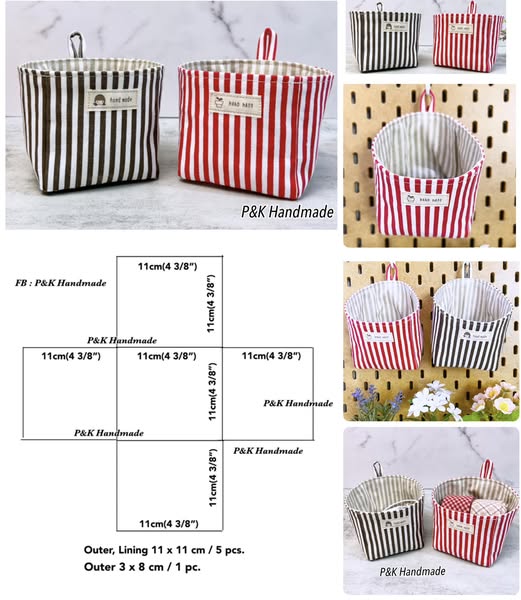Creating your own hanging storage is one of those projects that beautifully combines practicality with creativity. Whether you need extra space for small items in your sewing room, bathroom, or even a child’s bedroom, this DIY project is the perfect solution. The best part is that you can design it using your favorite fabrics and even incorporate elements of quilt techniques to make it look unique. By adding a simple quilt pattern, your hanging storage turns from ordinary to extraordinary.
In this tutorial, we’ll walk you through all the steps of making your very own fabric hanging storage. Don’t worry if you’re a beginner—this project is easy to follow, and you’ll get plenty of chances to personalize it to your own style. By the end, you’ll not only have a functional piece but also a handmade touch of creativity to add to your space.
So, grab your fabrics, sewing machine, and let’s dive into this project together!
Materials You Will Need
Before you start sewing, it’s important to gather all your materials. Having everything prepared will help the process go smoothly, and it will save you from unnecessary stops while working. For this hanging storage project, you’ll need a few essential sewing supplies, along with some fabric choices that match your style.
Here’s a basic list to get you started:
- 1 yard of sturdy cotton or canvas fabric (for the base)
- ½ yard of coordinating fabric for pockets
- Batting (optional, if you want a quilted look)
- Wooden dowel or curtain rod (to hang)
- Ribbon, twine, or fabric strips (for hanging loops)
- Sewing machine, thread, pins, and scissors
- Measuring tape and fabric marker
If you’d like to make your project more decorative, consider using small scraps of fabric and turning the pocket fronts into mini quilt blocks. A quilt pattern like half-square triangles, log cabins, or even a scrappy look can bring charm and texture to your storage. Adding this detail is not only a great way to practice quilting but also a way to bring color and personality into your room.
Preparing the Fabric
Once you’ve gathered your materials, the next step is cutting and preparing the fabric pieces. Start by measuring the space where you plan to hang your organizer. A common size is around 20 inches wide by 24 inches long, but you can adjust this depending on your needs. Cut your base fabric to this measurement, adding ½ inch to all sides for seam allowance.
Next, decide how many pockets you want. A simple layout could be three rows of two pockets, but you can also design it vertically with narrow pockets or horizontally with deeper ones. Cut your pocket fabric accordingly, making sure each piece is a few inches taller than the desired finished size so you can create a hem at the top.
If you’re incorporating a quilt pattern on the pockets, this is the moment to sew your quilt block design first. You can use leftover scraps, assemble them into a mini block, and then cut it down to the pocket size. Adding batting and quilting lines gives extra stability and visual interest. It’s a small touch that makes a big difference in the final project.
Sewing the Base
Now that your fabric pieces are ready, it’s time to assemble the base of your hanging storage. Start by folding the raw edges of the base fabric over by ¼ inch, and then fold again to hide the raw edge. Press with an iron and stitch all around to create a clean hem. This will prevent fraying and give the project a professional look.
If you want to quilt the background of your base fabric, place the batting behind it and add simple straight-line quilting across the surface. You don’t need a complicated design—a simple grid or diagonal quilting will give structure and durability. This is another chance to practice your quilting skills without committing to a large quilt project.
Once the base is hemmed and quilted, it’s ready to hold the pockets. Lay it flat and mark the placement of each pocket using your fabric marker. Double-check the spacing to make sure everything lines up evenly before moving to the sewing stage.

Making the Pockets
Pockets are the heart of this project. Begin by hemming the top edge of each pocket piece. Fold the fabric over about ¼ inch, press, then fold again and stitch to create a neat edge. This ensures the pocket opening is strong and won’t fray over time.
If you created quilted blocks for your pockets, treat them the same way—finish the top edge with a hem. The quilting will give them extra thickness and durability, making them perfect for holding small items without sagging. This is where adding a quilt pattern pays off, because it not only looks beautiful but also adds structure.
After hemming the tops, pin the pockets in place on the base fabric. Make sure to align them neatly and keep the spacing even. Sew along the sides and bottom of each pocket, reinforcing the stitches at the top edges where stress is most likely. If you’d like, you can also sew vertical lines within wider pockets to divide them into smaller compartments.
Assembling the Hanging Feature
With the pockets sewn on, the next step is preparing the top of your hanging storage for display. Cut a strip of fabric about 4 inches wide and the same length as the width of your organizer. Fold it in half lengthwise, press, and stitch it onto the top edge of the base, leaving a casing for the wooden dowel or curtain rod to slide through.
Slide your dowel into the casing, and then attach ribbon, twine, or fabric strips to each end of the dowel to create a hanging loop. This will allow you to easily hang the organizer on a hook or nail. Make sure the loop is strong enough to hold the weight of the filled pockets.
If you prefer a softer finish, you can sew loops of fabric directly to the top of the organizer instead of making a casing. Simply stitch evenly spaced loops that the dowel can pass through. Both methods work well, so choose the one that fits your style best.
Personalization Ideas
One of the best parts of this project is how easy it is to customize. You can make it colorful and fun for a child’s room, elegant and neutral for a living space, or bright and bold for a craft room. The choice of fabrics and patterns will define the overall look.
Incorporating quilting techniques into your pockets or base is a great way to add texture. For example, you could choose a star block, a nine-patch, or even a simple strip design for each pocket. A mini quilt pattern gives character and allows you to practice your quilting skills on a smaller scale before tackling a full quilt.
Other personalization ideas include adding embroidery, appliqué, or even labeling each pocket with fabric markers. You can also play with pocket shapes—make them angled, curved, or layered for extra interest. This project gives you the creative freedom to make it truly one of a kind.
Final Touches and Uses
Once your hanging storage is finished, it’s time to hang it up and start using it. Whether you place it in the bathroom to hold toiletries, in the kitchen for utensils, or in your sewing room to organize quilting tools, you’ll immediately see how useful it is. The pockets are practical, and the handmade design adds a cozy, creative touch to any space.
Because this project is portable, you can also make several organizers for different rooms. They make wonderful handmade gifts, especially if you personalize them with the recipient’s favorite fabrics or a small quilt pattern. Adding that personal touch shows thoughtfulness and creativity.
Don’t forget that hanging storage can also help reduce clutter. Instead of leaving items scattered on tables or shelves, you’ll have a dedicated spot to store them neatly. This simple project has the power to make your home feel more organized and welcoming.
Share Your Project
Now that you know how to make your own fabric hanging storage, it’s your turn to bring this idea to life. This project is perfect for beginners, and it allows you to explore both sewing and quilting techniques in a manageable, fun way. With a little creativity, you’ll end up with a beautiful piece that’s both practical and stylish.
We’d love to see your results! Share photos of your hanging storage and let others be inspired by your unique fabric choices and quilt designs. Whether you chose a simple layout or added a more elaborate quilt pattern, every project tells a story and reflects your personal style.
So, grab your fabrics, dive into this project, and don’t be afraid to experiment. Sewing and quilting are all about creativity and expression, and this hanging storage tutorial is just the beginning of what you can create.
